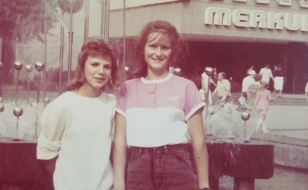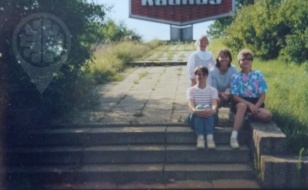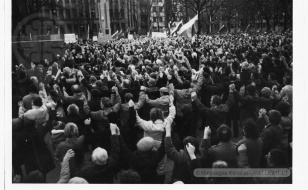
Audronė: „Pilis dabar atrodo visai kitaip.
*Audronė:* „Pilis dabar atrodo visai kitaip. Nebuvo tokio bokšto. Tada buvo apvalus kuoras, aišku, labai jau apgriuvęs, ir likusi siena, kuri dabar uždengta. Nuo jos labai gerai matėsi kunigų seminarijos kiemas. Mes nusiimdavome nuo pamokų, bėgdavome į tą kuorą ir žiūrėdavome, kaip klierikai su sutanom žaidžia krepšinį. Dar eidavome per tiltą, į Skriaudžių gatvę, į šlaitą. Sėdi ant šlaito ir žiūri, kaip mokyklos kieme kūno kultūros pamokas kas nors atlieka...“ (2019)
Read more
Audronė: „Pradėjau lankyti devintą vidurinę Senamiestyje.
*Audronė*: „Pradėjau lankyti devintą vidurinę Senamiestyje. Paskui ją pervadino į Adomo Mickevičiaus, o dabar tai jau Jėzuitų gimnazija. Dabartinėje Jėzuitų bažnyčioje buvo sporto salė. Ilgai stovėjo nenaudojama, paskui padarė sporto salę. O vienuolyne buvo mokytojų seminarija, kol į Marijampolę neiškėlė. Ten mokėsi studentai. Paskui padarė proftechninę mokyklą. Kavinės nė vienos nebuvo. Dabar aplinkui – vien kavinės, restoranai. Buvo knygynas prie Jakšto gatvės, gyvenami namai, kuro parduotuvė, maisto produktų parduotuvė. /.../ Maironio muziejuje buvo žaidimų aikštelė ir paties Maironio sodas. Su daug agrastų. Nuraškydavom dar žalius...“ (2019)
Read more
Laisvės alėja (Freedom Avenue)
Laisvės alėja (Freedom Avenue)
Read more
Rimantas: “This photo of my daughter Edita is taken in 1963, when she was 3.5-years-old.
*Rimantas*: “This photo of my daughter Edita is taken in 1963, when she was 3.5-years-old. I liked taking photos since my very childhood, we used to visit the garden in front of the Museum of War quite often, and this was where I captured her photo teasing the lions. I was working in a special scientific workshop, where various architectural and historic monuments were restored. Among many preserved architectural monuments in Lithuania, I also contributed to the repair of facades and interior of M. K. Čiurlionis National Art Museum and Museum of War. Your initiative inspired me to browse old photo archives. While looking for this photo, I looked through photos and slides featuring the construction of the Open-Air Museum of Lithuania, restoration of the Town Hall and Town Hall (Rotušės) Square, as well as reconstruction of The House of Perkūnas, the spire of Vytautas Magnus Church and many other monuments. Thus, I immersed into memories...” (2018)
Read more
Neringa: Yesterday, while driving from Vilnius to Kaunas, I saw the “new” sign of the city of Kaunas and realized that the old sign was a really special place.
*Neringa:* Yesterday, while driving from Vilnius to Kaunas, I saw the “new” sign of the city of Kaunas and realized that the old sign was a really special place. We would stop next to it every time we came back from Vilnius, even if relatives from America came to visit us. This was the first stop after Vilnius Airport, where we would all take photos with guests we haven't seen for a long time (or saw for the very first time). Even though the sign was a relict of the Soviet times, but compared to the “new” one, it had certain image and uniqueness to it. From my childhood, I remember those steps up to the sign and the red brightness of its background, that would contrast to the light blue summer sky. In this picture, it's me, my mother, and guests from America: Debbie and Ramutė in 1993. (2014)
Read more
Eglė: Hens running across the yard, pigs being farmed behind the house and the old horse of Kaunas silently sitting in the garage...
*Eglė:* Hens running across the yard, pigs being farmed behind the house and the old horse of Kaunas silently sitting in the garage... It is a description of a casual rural household after World War II, of one of the buildings located in Nemunas Street. Described as the Red-light district during the interwar period, the street was many times called the Venice of Kaunas as well, as the overflowing river used to flood the street. Despite the street being unknown to many tourists, and a few of who live in Kaunas since birth having been there, locals are full of memories. It is known that since the 1870’s, the property of land belonged to the town dweller Chaim Gidoni and after his death in 1876; to his family’s generations. In 1900, two-storey buildings (now Nemunas St. 14 and 14B) of red brick masonry were built. Later, in 1927 the property was sold to Benjamin Gruzdas, who was the owner of a jewellery store in Laisvės Avenue and the official provider of Omega watches. The oldest residents remember themselves being children, sitting in the house and watching playfully the overflowing river. Together with floating giant floes (heet of floating ice) the river used to flood almost up to the windows of the ground floor of the Nemunas St. 14B building. Ms. Elena was one of these children, who grew up listening to the clamour of children’s voices and saw adults organising birthday celebrations with food, music and dances until sunrise. However, not all of the memories cause nostalgia. According to Mr. Levas, several tragic accidents have happened: during one of the floods, a woman drowned when she accidentally fell into the basement, a German military officer jumping out from the balcony of building 14B, and one woman burned alive in the fire of a storehouse where she lived. Another local resident, Romas, remembers the times when several families had to live in one small apartment. Once, his mother hosted two students, who protested against the Soviet Union government by sewing so called “granny” pants out of the union’s flag and hanging it on the fence next to the parterre. These past stories allow people to feel the spirit of the street and re-live every moment experienced by former residents of Nemunas street.
Read more
„Ne kiek to baisiausio žmonijos istorijoj karo Tadas ir beprisimena – keli paveikslai, ir tie neaišku, ar paties prisiminimai, ar vėliau išgirsti žmonių pasakojimai, pavirtę prisiminimais, keli pablukę vaizdai: vienas iš Kauno, antras iš Vilniaus, trečiasis iš Veprių.
„Ne kiek to baisiausio žmonijos istorijoj karo Tadas ir beprisimena – keli paveikslai, ir tie neaišku, ar paties prisiminimai, ar vėliau išgirsti žmonių pasakojimai, pavirtę prisiminimais, keli pablukę vaizdai: vienas iš Kauno, antras iš Vilniaus, trečiasis iš Veprių. 1938 metais gimęs, trijų ketverių penkerių metų bamblys – kas gi tokio peliuko galvoj galėjo įstrigti? Ugnis? Sprogimas? Gaisrų pašvaistės? Ir vis dėlto šį tą prisimena: ant aukšto kalno – minia žmonių, visi tyli, visi žiūri į žemumą, į tolimą duobę, kurioje kažkas liepsnoja, virsta dūmais, bet neįžvelgsi kas (dabar Tadas jau žino: tai liepsnojo Kauno Slabados rajonas, vokiečių paverstas getu ir sudegintas, tame priemiesčio kampe glaudėsi ir jo tėvų namelis, o tie ant aukšto kalno stovintys žmonės, tos raudančios moterys – tai Slabados gyventojai, išvaryti iš savųjų gūžtų kaip stovi – visiems jiems teko viską pradėti nuo pradžios: ir butelius susirasti, ir baldelius susikalti, ir vėl iš naujo išmokti gyventi, mylėtis, daryti vaikus, o laikui bėgant ir vagiliauti, ir apgaudinėti), tik kruvina pašvaistė ant žmonių veidų, kruvinos kibirkštys raudančių moterų ašarose“.
Read more
When I was sixteen, it was the first time, when I brought my photo camera to the Oakwoord Park, Darius and Girėnas Sports Centre, the Hall and the Stadium.
When I was sixteen, it was the first time, when I brought my photo camera to the Oakwoord Park, Darius and Girėnas Sports Centre, the Hall and the Stadium. It was during the World Lithuanian Games in the summer of 1991. I followed the participants marching from the Old Town. There were crowds of people, great mood, no mournful atmosphere. The second day of the Games was coloured in bright green: a boy who carried Detroit Kovas flag gave me five dollars for a photo that I handed him when we met. My first honorarium in cash! As my aunt Zita (currently living in Detroit) found out, his name was Tadas Baukys. The euphoria did not last long. Shots were fired at the Lithuanian boarder and the crowds moved to Vilnius: again, for a funereal.
Read more(Saulius Eduardas Pauliukonis, actor of Šiauliai Drama Theatre, former actor of Kaunas Pantomime troupe, who worked in Kaunas Drama Theatre with director J.
(Saulius Eduardas Pauliukonis, actor of Šiauliai Drama Theatre, former actor of Kaunas Pantomime troupe, who worked in Kaunas Drama Theatre with director J. Jurašas and in Kaunas Musical Theatre).
Read more
Mindaugas Kavaliauskas: It was a rally to support the Act of March 11 and show our unity.
Mindaugas Kavaliauskas: It was a rally to support the Act of March 11 and show our unity.
Read more
Gintaras: In Vilniaus Street, next to the underground passage, there is a building with niches, in which three little sculptures were placed.
*Gintaras: *In Vilniaus Street, next to the underground passage, there is a building with niches, in which three little sculptures were placed. Unfortunately, they did not stand and entertain the passers-by for a long time. They were vandalized one night. It was around 1988, I don't remember for sure. But a place is never empty, and these three beauties occupy this place right now :) (2014)
Read more
Eugenija: "I remember, when they destroyed Stalin’s monument.
Eugenija: "I remember, when they destroyed Stalin’s monument. The windows of our apartment were facing the appendix. From the window I could say that the traffic had been stopped, people couldn’t walk across the street, nor go down the street of Parodos. A truck arrived. It was dark, a lot of police. I saw how they threw ropes on it, pulled them and demolished it. The leftover pieces were put in the truck. A policeman was even standing near the gates of our yard." (2019)
Read moreSITES OF MEMORY
1 Projects 114 12 Routes
Our memory is framed by spatial reference points: places, sites, buildings, and streets give us our bearings and enable us to anchor and order our memories. So, the material alteration of these places can lead to the substantial modification of our memories, and even their disappearance.Post your memory here